
Trees, cones, foliage and seeds; by Matt Strieby [2023].

Mature trees in habitat [C.J. Earle, 2014.01.19].
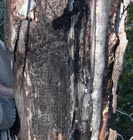
Catface, showing multiple fire scars, on one of the trees shown above. A. bracteata is one of the most fire-tolerant trees in the genus [C.J. Earle, 2014.01.19].

Foliage and buds on an arboretum specimen, Seattle, Washington [C.J. Earle, 2019.03.16].

Twig, foliage and buds, upper side (scale in inches) [C.J. Earle, 2014.01.19].
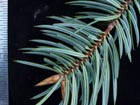
Twig, foliage and buds, lower side (scale in inches) [C.J. Earle, 2014.01.19].
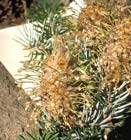
Mature cones. © Br. Alfred Brousseau, Saint Mary's College.
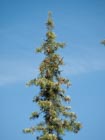
Crown of mature tree in habitat with disintegrating cones [C.J. Earle, 2014.01.19].
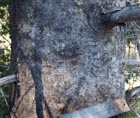
Bark on mature tree in habitat [C.J. Earle, 2014.01.19].
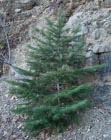
Sapling in habitat, about 6 to 8 years old [C.J. Earle, 2014.01.19].
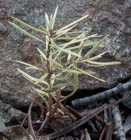
Seedling in habitat, about 40 mm tall [C.J. Earle, 2014.01.19].

An area burned 6 years earlier shows extensive residual A. bracteata and Pinus lambertiana (minor P. coulteri), also abundant regeneration [C.J. Earle, 2014.01.19].
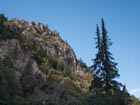
This very steep site is effectively fireproof, and covered with A. bracteata [C.J. Earle, 2014.01.19].
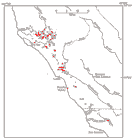
Distribution of Abies bracteata (Griffin and Critchfield 1972).

Illustration, 1854 (links to Botanicus.org).

Abies bracteata
D. Don ex Poiteau 1845
Common names
Santa Lucia, bristlecone, or silver fir; fringed spruce (Liu 1971).
Taxonomic notes
Syn: A. religiosa sensu Hook. et Arn. 1833, A. venusta Douglas 1836, Pinus bracteata D. Don 1836, Picea bracteata (D. Don) Loud. 1838, A. bracteata (D. Don ) Hook. et Arn. 1841, Taxodium sempervirens Hook. et Arn. 1841, A. bracteata (D. Don) Nuttall 1849, Sequoia religiosa (Hook. et Arn.) Presl 1851, A. venusta (Douglas) K. Koch 1873 (Liu 1971).
Description
A narrowly conical tree 12-30 m tall, 10-30(100) cm dbh, with a spire-like crown and with short, slightly drooping branchlets. Bark light red-brown, thin, smooth, with age becoming slightly fissured and broken into appressed scales. Branches diverging from trunk at right angles, the lower often drooping in age. Twigs smooth to somewhat pubescent, shiny light reddish-brown, purplish green or brown. Buds exposed, ovate to fusiform, pale yellowish-brown, sharp-pointed, 10-20 mm long, not resinous, apex pointed; basal scales short, broad, equilaterally triangular, glabrous, not resinous, margins entire, apex sharp-pointed. Needles 2-ranked to spiraled, flattened, stiff, with raised abaxial vein, pointing forwards, distinctly parted, shiny dark green above, (25)35-55(60)mm long by 2.5-3 mm wide, with 2 broad white bands below with with 8-10 stomatal rows on each side of midrib; odor pungent; base twisted; apex long-spined; cross section flat-convex; resin canals small, near margins and abaxial epidermal layer. Staminate cones at pollination pale yellow to yellow-green, 5-7 cm long by 2-3 cm wide. Ovulate cone ovoid, resinous, (6)7-10(14) cm long by 4-5.5cm wide, violet-brown to purple-brown, borne on stout peduncles; scales ca. 1.5-2 × 2-2.5 cm, glabrous, thin, rounded, finely serrulate; bracts long exserted, not reflexed, trilobed, yellowish-brown, extending 4-5 cm beyond the scales, resinous. Seeds shiny, deep red-brown, 5 mm long, wing 8-11 mm long; cotyledons ca. 7 (Talley 1972, Silba 1986). Flowers bloom in early May, cones mature and disperse seed from late August to October (Liu 1971). See García Esteban et al. (2004) for a detailed characterization of the wood anatomy.
"For a fir, this tree has many unusual characters: large sharply tipped "xeromorphic" needles, thin bark (leading to fire susceptibility), persistent lower branches (even when trees are 4 feet DBH and 150 feet tall), an Indian club shaped crown, non-resinous buds and, of course, protruding cone scale bracts. These bracts have been found to merge imperceptibly into normal needles in mutant cones of one tree sampled in Tilden Regional Park, Oakland, 1971. However, the chromosome number is 24 like the rest of the Pinaceae except Pseudotsuga, and the karyotype is distinctly that of an Abies" (Talley 1972).
Distribution and Ecology
US: California: Santa Lucia Mountains. This area is a narrow coastal strip in the Los Padres National Forest (Little 1980).
Distribution data from GBIF (2020).
Climate is Mediterreanean with about 500-1300 mm annual precipitation. Hardy to Zone 7 (cold hardiness limit between -17.7°C and -12.2°C) (Bannister and Neuner 2001). Found in moist canyon bottoms and rocky slopes where fuel accumulations do not permit fire. Latitude range is entirely between 36 and 37°N, and altitude varies from 180 to 1,570 m (atop Cone Peak). Common associates are Pinus coulteri, P. ponderosa, Pseudotsuga menziesii, and Quercus chrysolepis (Liu 1971). See also Thompson et al. (1999).
The following paragraphs are quoted verbatim from Talley (1972).
Santa Lucia fir, Abies bracteata, is the rarest fir in the world, being endemic to California's Santa Lucia Mountains. Within these mountains it occurs in scattered groves ranging in elevation from 600 to 5150 feet, with most stands on north- and northeast-facing slopes. Above 4500 feet individuals will occasionally be found on south- and southeast-facing slopes; these trees can always be traced to relatively moist, sheltered microsites. Stands below 1700 feet are rare and are always at the bottom of a large canyon, where cold air drainage is important. The lowest stand ranges between 600 and 900 feet at Ventana Camp on the Big Sur River. This location lies at the bottom of a 300-foot-deep canyon, in the redwood belt, and is freqently foggy. These data suggest low water potentials [I suspect he means low in absolute value] as an important limiting factor in the trees' distribution. Site index of mature fir, needle dimensions, and seed and cone size all point toward this conclusion. There are no successful records of introduction for the eastern United States, while numerous groves thrive in Europe. This suggests that Santa Lucia fir may also require equable temperatures. Further evidence of a requirement for equable temperature can be seen in needle dimensions (relation of length to width), but this is still speculative. The role of water potential and temperature upon the growth and development of Santa Lucia fir is now being examined more closely in both the field (for mature trees and first season seedlings) and in the controlled environments of the Phytotron at Duke University.
The widely scattered nature of fir groves within the Santa Lucia Mountains is primarily due to this tree's susceptibility to fire injury, although competition with other vegetation and aspect are also important. Large stands of fir are always in regions of precipitous cliffs or steep-rugged canyons which are steep enough to prevent litter accumulation extensive enough to carry a strong fire. This also provides a mineral soil surface for germinating seed. Both influences are considered important. The Buckeye Canyon fire of Sep 1970 presented a vivid example of how this tree is restricted by fire. This fire was one of the hottest, certainly the largest, of several decades. Whole slopes were completely "cleaned off", while the two fir stands in the burn received only ground fires, or didn't burn at all. Santa Lucia fir not only appears to be restricted to generally fireproof topography, but may even be restricted to regions where the topography makes it impossible for a fire to enter a grove going uphill.
There has been speculation that either fire or insects will eliminate this tree in the near future. While fire has certainly reduced the fir's potential range within the Santa Lucia Mountains, and two species of seed calcid (Megestigans(?)) normally inflict 100% mortality on the annual seed crop, and a green larva (probably a moth) severely defoliates the young shoots, the fir does not appear to be in any immediate danger of either extinction or further range restriction. Good seed crops are occasionally produced by the fir's ability to repond to climatic fluctuations with a dramatic fluctuation in annual cone production, thus literally swamping the wasps with more seed than they can parasitize in one year, and producing next to no cones the subsequent year. Quantitative data for this phenomenon are still being analyzed but tentative conclusions point directly for an interaction of climate and past cone production leading to cone production on much the same basis as wide versus narrow rings are produced in trees of semi-arid climates. As for the green larvae which defoliate both young and mature trees, the larvae will simply have to be raised and the life cycle reconstructed. As for the score of wood boring beetles that attack fir trunks and branches, their total impact is not alarming, and, like the other insects, appears to represent a stable equilibrium.
Santa Lucia fir may also be resistant to air pollution as the Tilden Park grove is thriving, as are trees in San Francisco and Europe. With most of the range in the Los Padres National Forest (Monterey unit) and on the Heart Ranch there seems to be little daanger of this tree's habitat being disturbed. The only use the tree may find outside of watershed control and contributing to the beauty of the Santa Lucia Mountains is as an ornamental. With the Tilden Park grove now producing an abundance of pest-free seed more and more of these beautiful trees should be planted.
Remarkable Specimens
As of 2020, the official largest tree is in Monterey County. Discovered in 2006, it was last measured in 2016 as 121 cm DBH and 38.7 m tall, with a crown spread of 7.9 m (American Forests 2020). Larger trees have been recorded in the past. Frank Callahan (email 2020.07.30) reports "In 1976 the late Dr. James Griffin and I measured a very large fir in the Los Padres N.F. inland from Carmel. The tree was 162" circumference [131 cm DBH], 182' [55.5 m] tall with a 38' [11.6 m] crown spread with branches to the ground. This tree was the National Champion recognized by American Forest Big Tree Program in 1986. The tree was killed by dehydration during a large fire several years later, in other words all the yellowed needles were on the tree during a visit after the fire."
Ethnobotany
The aromatic resin was used as incense in the early Spanish mission nearby (Little 1980).
Observations
Since this is not a widespread species, and since most of its locations in habitat are difficult to access, I present here a fairly detailed guide. If you wish to visit the area, I also recommend a review of Griffin (1975).
- One of the best, and easily the most accessible occurrence, is at Cone Peak, which is at the end of the Cone Peak Road (N 36.05362, W 121.49123). This is a large and healthy stand. Along the way you can also see good examples of Pinus coulteri, P. lambertiana, P. attenuata and P. ponderosa. This 10 km National Forest road is closed behind a locked gate much of the year, so a bicycle is useful.
- There are a number of collections recorded near the Tassajara Mountain Zen Center. The Center is closed from September to May but otherwise is fairly easy access, requiring only a 20 km drive on an unpaved road. I haven't seen the site but the reported collections are right at the Center.
- According to Rogers (1998), "To the north populations are scattered from Skinner's Ridge [ca. N 36.323 W 121.613] to Miller's Canyon [ca. N 36.323 W 121.613], with additional populations east of Tassajara Road in Anastasia Canyon and in the canyon of Calaboose Creek. ... The largest concentrations occur from the Ventana Double Cone [N 36.2969 W 121.7149, has lookout and trail] area to Miller's Canyon [ca. 7 mi ENE], and in the vicinity of Cone Peak." Most of this area is difficult of access, located deep in the Ventana Wilderness, although there is a fairly extensive trail system. Skinner Ridge, however, is only about a 3 km hike up from the Bottchers Gap Campground, which is accessed by a paved road. I haven't visited the site. I expect access may be difficult during the winter months.
- Rogers (1998) also states that "Southward the populations gradually become restricted to the Coast Ridge, although there is a population on the north slope of Junipero Serra Peak (in the canyon of Santa Lucia Creek). The southern-most documented populations are located in the watershed of the Arroyo de la Cruz (near Hearst's Castle)." The Santa Lucia Creek trees are not near any trail and the terrain is extremely steep; access appears challenging. Griffin (1975), who provides an intriguing description of Junipero Serra Peak, says the trees are uncommon on the north slope of the peak at 600 to 1200 m elevation, which is in or a bit above the bed of the creek. The Arroyo de la Cruz is crossed by a decent road at N 35.69870 W 121.17126 and may provide fairly easy access, assuming the road is open.
There are also a number of reported herbarium collections (from the Consortium of California Herbaria) that have fairly specific location data. There is a real risk that the trees at these collection sites may have since been extirpated by fire or other disturbance. I have not visited any of them.
- A 1997 collection at N 35.953, W 121.403, "San Miguel Crk, below and S of McKern Trail", 730 m, mixed-evergreen forest, partially burned 1996. This is on Fort Hunter Liggett, and there may be access restrictions.
- A 1974 collection at N 36.193 W 121.577, "ca. 200 meters upstream from zig-zag campground." This is pretty remote backcountry.
- A 1949 collection at N 35.913 W 121.378 in Willow Canyon, "3 ft. diameter, 120 ft. tall." This is quite a remote area.
- A 1930 collection at N 36.257 W 121.430, near Arroyo Seco Road, which appears easy to access.
- An 1898 collection by Plaskett at N 35.9181 W 121.4454, up an old road E of the town of Plaskett, which appears to be accessible with a hike of about 2 km.
Remarks
First found by Thomas Coulter in 1831 and afterwards collected by David Douglas, Karl Hartweg, and others. One of the handsomest trees in the genus (Liu 1971).
"There has been considerable conjecture as to this tree once having a wider range. The fossil record attributed to this tree in the past, however, is a series of misidentifications, and no sound evidence exists for this tree in any fossil flora, excepting one possible needle and seed from western Nevada, and this is still under study by Dr. Axelrod at U.C. Davis. We have no idea as to when the fir arrived in the Santa Lucia Mountains or where it came from. As to why it is not found elsewhere in the West today we can ask ourselves: Where else can high equability, heavy winter rains with long dry summers, and large areas of fireproof topography be found. The answer is nowhere but the Santa Lucia Mountains for all of western North America" (Talley 1972).
Frank Callahan (email 2020.10.02) reports "I made seed collections from these trees... the trees' best defense are droplets of resin. I wore a total rain suit, that covered my head and a full face clear plastic visor and was totally covered with pitch at the end of the day." Frank also reports that the branch strength is much greater than is typical of true firs, comparable to Pseudotsuga menziesii.
Citations
Griffin, James R. 1975. Plants of the highest Santa Lucia and Diablo Range peaks, California. USFS Research Paper PSW-110. Berkeley: Pacific Southwest Forest and Range Experiment Station. www.fs.fed.us/psw/publications/documents/psw_rp110/psw_rp110.pdf, accessed 2013.11.26.
Poiteau, A. 1845. Des Conifères. Rev. Hort., ser. 2, 4: 4-13.
Rogers, David. 1998. Perfect pattern of silvan perfection on the symmetrical plan, the rare Santa Lucia fir. Double-Cone Quarterly 1(2). http://www.ventanawild.org/news/fe98/slfirs.html, accessed 2013.11.27.
Talley, Steven N. 1972.06.08. Notes concerning the status of ecological studies on Santa Lucia fir, Abies bracteata. Not known to have been published; manuscript acquired in 1989 from files of a Los Padres National Forest district ranger office.
See also
Elwes and Henry 1906-1913 at the Biodiversity Heritage Library (Photo). This series of volumes, privately printed, provides some of the most engaging descriptions of conifers ever published. Although they only treat species cultivated in the U.K. and Ireland, and the taxonomy is a bit dated, still these accounts are thorough, treating such topics as species description, range, varieties, exceptionally old or tall specimens, remarkable trees, and cultivation. Despite being over a century old, they are generally accurate, and are illustrated with some remarkable photographs and lithographs.
Farjon, Aljos. 1990. Pinaceae: drawings and descriptions of the genera Abies, Cedrus, Pseudolarix, Keteleeria, Nothotsuga, Tsuga, Cathaya, Pseudotsuga, Larix and Picea. Königstein: Koeltz Scientific Books.
- Provides a detailed account, with illustrations.
FEIS database: "This review summarizes the fire effects information and relevant ecology of bristlecone fir that was available in the scientific literature as of 2020."
Hunt (1993).
Liu (1971).
Rogers, David. 1998. An addendum on the botanical history of Santa Lucia fir, Abies bracteata, with excerpts from the notes and letters of early collectors. Double-Cone Quarterly 1(3). http://www.ventanawild.org/news/ws98/slfirs2.html, accessed 2009.04.17.
Talley, Steven N. 1970. The ecology of Santa Lucia fir (Abies bracteata). Rep. for Bot. 258 & 299, Univ. Calif., Davis. 332 p., illus.
Talley, S.N. 1974. The Ecology of Santa Lucia Fir (Abies Bracteata), A Narrow Endemic of California. Ph.D. dissertation, Duke University.















